For the contractor who installed the mass timber frame of the super-sustainable PAE Living Building in Portland, the devastating 2020 wildfires in Oregon truly hit home.
Last Sept. 8, after a COVID-19-prompted “staycation” over Labor Day weekend, Russ Brotnov, CEO of Carpentry Plus Inc., received a distressing call from his wife. Wildfires were threatening their new house outside Estacada, about 30 miles southeast of Portland. They had to evacuate.
Brotnov rushed home from his office in nearby Sandy to meet his wife and pick up their son, then a high school junior. “You could see the fires on the hills,” he says. “It was ominous.”
The trio retreated to the Carpentry Plus shop in Eagle Creek. The next day, armed with a chain saw, Brotnov returned home. He cut through smoldering fallen trees to get to his house, which he found still intact. After turning on the lawn sprinklers, he left, hoping the still-threatening wildfires would spare his home.
“Things have been going well in a really challenging time. It could have been a lot worse.”
— Jill Sherman, Partner, Edlen & Co.
They didn’t. The house burned to the ground Sept. 10. “We lost everything,” says Brotnov.
At the same time, smoke and ash from the wildfires had shrouded Portland in hazardous smog. “It was very scary, to say the least,” says Kyle Heckaman, project superintendent for Walsh Construction Co/OR (WCC), the general contractor for the 58,000-sq-ft PAE building.
The air quality became so bad that on Sept. 11, WCC shut down work on the reinforced concrete core for four days. “We ended up sending the crews home [because] the smoke had made any physical activity almost unbearable,” says Heckaman.
After the fires subsided, the Carpentry Plus crew surprised the Brotnovs and began converting part of the shop into temporary living quarters. The family stayed in a neighbor’s basement for three weeks before moving back to Sandy.
The crew finished the living space by Oct. 12, in time to begin the PAE mass timber installation. Despite the trauma from the wildfires, Brotnov and his crew didn’t “miss a beat” on the PAE project, says Paul Schwer, president of PAE—the mechanical-electrical-plumbing (MEP) engineer and the building’s main tenant.
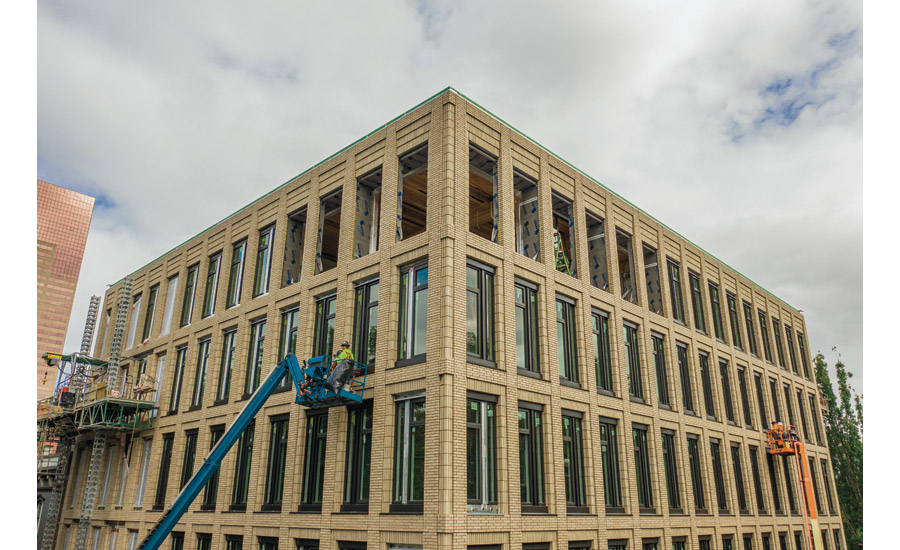
Brick exterior is inspired by the location in the Skidmore/Old Town national historic district.
Photo by Jamie Goodwick
*Click on the image for greater detail
Living Building Firsts
The $40.2-million office development, with ground-floor retail, is taking both sustainability and seismic resilience to new levels. It is on course to be the first privately developed speculative office building fully certified under the rigorous Living Building Challenge sustainability program of the International Living Future Institute (ILFI). It is the first Living office building in a dense urban setting, which comes with its own challenges, primarily related to solar photovoltaic (PV) capacity and export of surplus power to the utility. And the location in the Skidmore/Old Town national historic district came with restrictions on the architecture that complicated design, according to ZGF Architects.
Portland is in earthquake territory. The five-story project also is one of a very few spec office buildings and the only Living Building engineered beyond code minimums for hospital-level seismic resilience. The densely reinforced shear-wall core surrounded by glue-laminated timber (glulam) columns and beams and concrete-topped cross-laminated timber (CLT) floor diaphragms should allow the building to survive a magnitude-7.5 quake with barely a scratch, according to the structural engineer, KPFF.
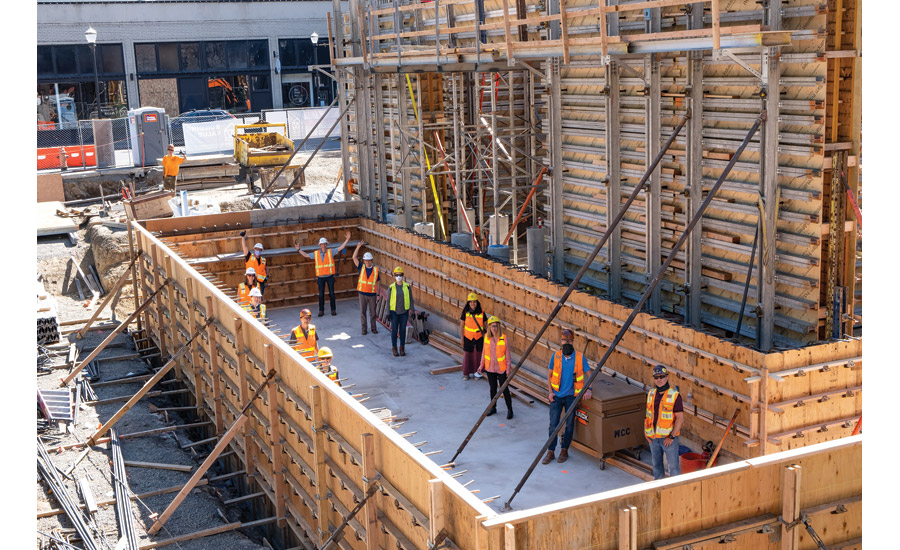
Green equity investors, including PAE, Edlen and WCC, in the cistern.
Photo Courtesy WCC
*Click on the image for greater detail
In addition to the usual exotic MEP systems of Living Buildings, PAE contains the first commercial installation in the Americas of a nutrient recovery system that will produce agriculture-grade fertilizer from nutrient-rich urine and the first large-scale commercial installation of vacuum-flush toilets.
Even the business relationships are novel. WCC, ZGF and PAE have equity in the project, mostly in the form of donated fees. “This project has a lot more inherent risk because it has not been done 100 times,” says Ed Sloop, chief estimator and senior project manager for WCC, which is new to Living Buildings. “Having knowledgeable subs and engineers that embraced the challenge was paramount,” he adds.
After 28 months of preconstruction, WCC broke ground on April 1, 2020, three months later than planned. That delay, mostly attributed to permit “slide,” shifted all activities to the next season, which had some negative impacts. For example, mass timber, best installed in the dry season, went in during the rainy season.
Pandemic stress and safety protocols plus wildfires and smog would have been enough to test anyone’s mettle. But there were more crises ahead for the PAE team.
The 58,000-sq-ft PAE Living Building, more than 85% complete, is breaking several Living Building Challenge records. It is the first privately developed Living office building, the only seismically resilient Living Building and the only commercial building that will turn urine into fertilizer.
*Click the image for greater detail
On Feb. 12, a freak ice storm combined with predicted heavy snow slammed the region, bringing down power lines and making roads treacherous. In advance of the storm, WCC had sealed the building, already covered by a temporary roof but with window openings, as much as possible. Though the site itself did not lose power, Heckaman estimates three quarters of the job’s workforce was without power at some point.
Heckaman was the only one to make it to the site that day. “We did not have anyone else come in, for I could not guarantee a safe workplace due to the ice,” he says.
The storm caused a two-day delay and slowed the permanent roof installation, which was already more difficult to do in cold weather.
The PAE team was not out of the woods yet. On March 23, B&B Masonry had to shut down its entire exterior-wall bricklaying operation because a mason, who had been in close contact with others on the scaffold, tested positive for COVID-19. Other work in the building continued, but the shutdown caused a seven-day delay because the brickwork was on the critical path.
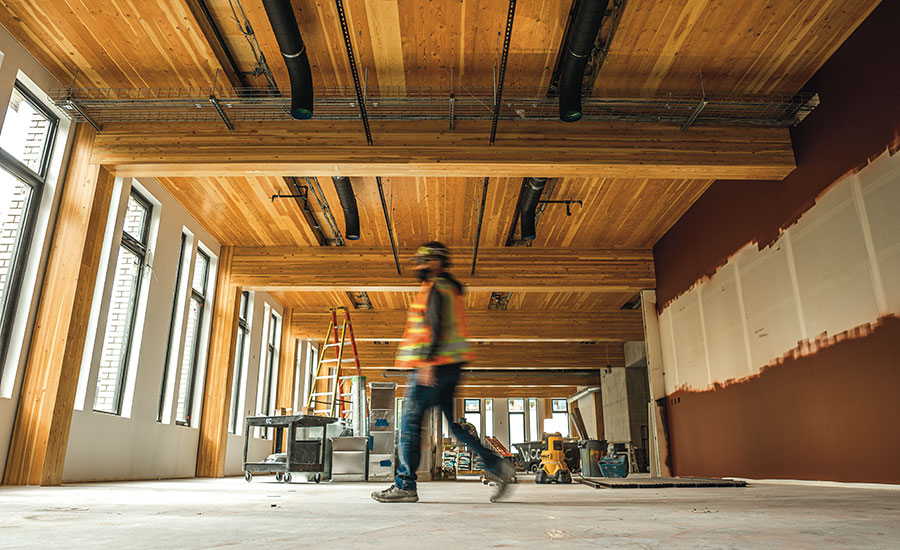
The underside of the CLT panels, which contain mechanical chases, are architecturally expressed.
Photo by Jamie Goodwick/Portland Drone
*Click the image for greater detail
Though many are vaccinated, pandemic safety protocols remain in place. COVID-19 “is definitely something hanging over our heads,” says WCC’s Heckaman. But of nine COVID-19 disruptions, only the B&B shutdown had an impact on the critical path.
Early in the work, the PAE team had still another situation to monitor—some five months of civil unrest downtown triggered by the May 25, 2020, police killing of George Floyd in Minneapolis. WCC had extra security measures put in place as a precaution, but the demonstrations, primarily about 12 blocks away, did not affect the PAE job.
“We weren’t just being challenged by ILFI, we were being challenged by powers outside our control,” says Heckaman.
Through it all, the team forged ahead. The project is on course for completion Sept. 7, though the schedule has slipped 12 days.
Living Buildings cost more than ordinary ones, says Jill Sherman, a partner of developer Edlen & Co., which also is taking space in the building. Still, the project is meeting its $25.2-million construction budget, she adds. “Things have been going well in a really challenging time,” says Sherman. “It could have been a lot worse.”
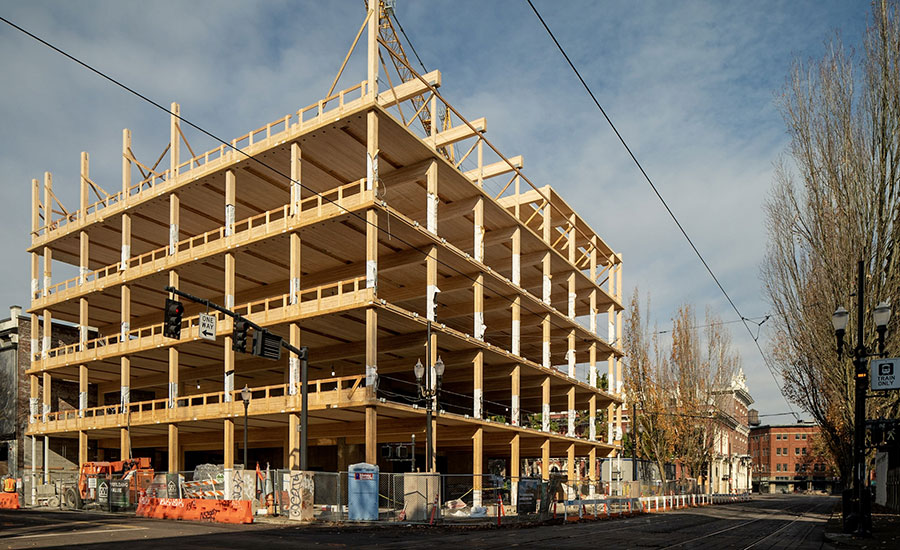
The installation of the mass timber frame was one of the most challenging aspects of the project, especially because a delayed start pushed the work into the wet season.
Photo by Jamie Goodwick/Portland Drone
*Click the image for greater detail
Multiple Interconnected Systems
In terms of Living Building Challenge construction, WCC’s Sloop ranks installing the plumbing for net-positive annual water use as the most demanding, because there are multiple interconnected systems. These include composters, vacuum-flush toilets, waterless urinals with urine recovery, and separate gray water and rainwater recovery and treatment. “Net-positive water systems are expensive and require buy-in from code officials,” Sloop says.
In terms of difficulty, net-positive energy is tied with products and materials selection, necessary to minimize the so-called Red List of banned ingredients. The mass timber frame ranks next in difficulty, followed by the imperative for net-positive waste.
A materials research team, with representatives of WCC, the design team and two consultants, Brightworks and Integrated Eco Strategy, has to preapprove all products and materials. The total count of products considered to date exceeds 2,737, but “we are very close to being complete,” says Sloop.
WCC donated the services of a project manager to deal with the extra steps in the submittal, procurement and check-in processes. WCC inspects, photographs and records each delivery to make sure it matches the database of approved products. There have been about 20 times the check-in system flagged unapproved products that were then vetted and occasionally rejected, according to WCC.
Meeting the materials imperative led to some breakthroughs, according to ZGF. For example, Dura Industries elected to invest in new equipment to be able to offer an acceptable coating for aluminum. A durable roof membrane from Carlisle, called FleeceBACK TPO, was already certified. However, Carlisle, as requested by ZGF, put the product through testing and certification to ensure the material was safe to collect the rainwater supply for the potable-water treatment system.
ZGF also worked with Cascadia Windows & Doors to create a larger operable casement window than originally approved. And the PAE team worked with Oregon Door to provide 100% Forest Stewardship Council wood and wood-veneer doors that are fire-rated.
Meeting the net-positive energy imperative required some creative thinking, says Sloop. The 115-ft x 95-ft building does not have enough roof space for the 328 kW PV array needed. Historic-district rules prohibit roof overhangs. Even with slanted panels, there is space for only a 132.6-kW array.
A 2018 Living Building Challenge exception, to encourage buildings in dense urban settings, allows offsite power generation to count toward net-positive energy. As a result, PAE’s core group funded a 195.4-kW PV array on a WCC-built project nearby—the Renaissance Commons affordable housing. The offsite array also filled the PAE team’s equity obligation for certification, which calls for the donation of half a cent or more of every dollar spent on the project to a charity or to ILFI’s Living Equity Exchange Program.
There were other power snags. Typically, owners of solar arrays have a net-metering arrangement with a utility that allows them to export to the grid any surplus power generated during the day. Exports build up energy credits for power purchases when the PV array is not producing electricity. “In effect, net-metering allows the grid to act like a large virtual battery for the customer,” says Craig Collins, a PAE electrical engineer.
In urban cores, clusters of buildings are often part of an area network—an interconnected distribution system served by multiple feeders that is more reliable than a simpler radial network. But with an area network, backfeeding the grid can cause outages. Consequently, the utility, Portland General Electric, puts limits on exports, explains Darren Murtaugh, PGE’s manager of grid-edge solutions.
PGE initially limited the PAE building to export a maximum of 57 kW. As a result of reduced demand in the area during COVID-19, PGE reduced that number to 49 kW.
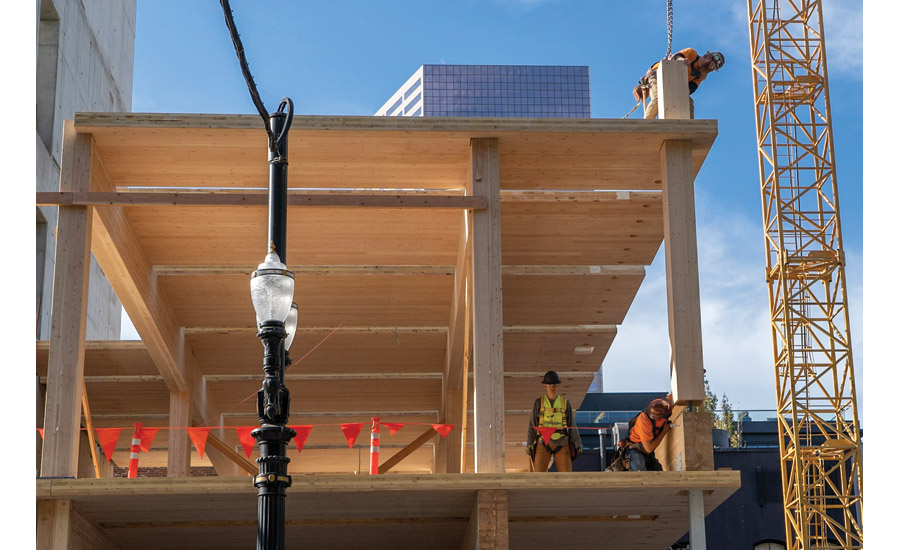
Voids for mechanical chases are visible in top level of CLT panels before crews created a temporary floor diaphragm for stability. The diaphragm cut the timber installation time from 10 to five weeks.
Photo courtesy of Oregon Dept. of Forestry
*Click the image for greater detail
The allotment is nowhere near the 132.6-kW generating capacity. Onsite battery storage was the only option for the team to meet the net-positive energy imperative. Batteries are already required for emergency power. PAE was able to upsize the battery to store excess power that could not be exported. A microgrid control system manages the exports and backfeeds the grid at night, when the PV array is not producing power.
ZGF and PAE located the battery module in the first-floor mechanical room. All was going well until the battery supplier, LG Chem, indicated it would no longer provide modules for indoor installations. PAE and ZGF were almost done with a reluctant redesign for a rooftop location when they were informed that LG Chem was no longer going to supply the battery. Eventually, after more research, the team found a supplier that would provide an indoor module, says Collins.
The building’s modeled energy use intensity is 18.6 kBtu per sq ft per year. The low EUI would allow the building to produce 5% more energy than it uses, with a 10% safety factor.
To PAE’s surprise, its own new generation of IT equipment draws more power, which was adding to EUI creep—to 19.5 kBtu per sq ft per year. To reduce its electric plug loads and the EUI, PAE has servers that use 10% less energy than traditional servers. For both its cloud and onsite systems, PAE will further reduce plug loads by shutting down services when they are not in use.
In addition, PAE is going “wireless first” to minimize both network switch and cabling infrastructure, says Scott Schuetz, PAE’s chief information officer. Instead of network ports at every desk, all staff will connect to wireless access points.
PAE consulted with an engineer from Juniper Networks, its network equipment maker, to find ways to track and reduce network energy consumption. As a result, its network resources and wireless access points will automatically shut off during nights, weekends and holidays, when offices are unoccupied.
Employees also will use encrypted laptops and take them home daily for energy savings, business resilience and security purposes. In-office dual-monitor configurations will be replaced by single ultrawide displays that use less energy.
PAE will also eliminate most printers and all plotters. Engineers will do mark-ups on tablets and other touchscreens, using styluses.
While PAE was finding ways to trim its energy use, others spent considerable energy of a different kind to prevent water damage to the glulam and CLT during the wet-season installation.
The timber moisture mitigation plan included taping and caulking panel seams and edges to prevent staining of the architecturally expressed beams and columns below the panels. Whenever it rained, a crew of four to six with squeegee brooms would remove water from the decks to prevent puddling.
Blowers circulated air but heating was not an option because drying out the panels too quickly could cause cracking, twisting and possibly delamination, says WCC’s Sloop. Weekly moisture tests at all floors ensured the timber was drying at the proper rate.
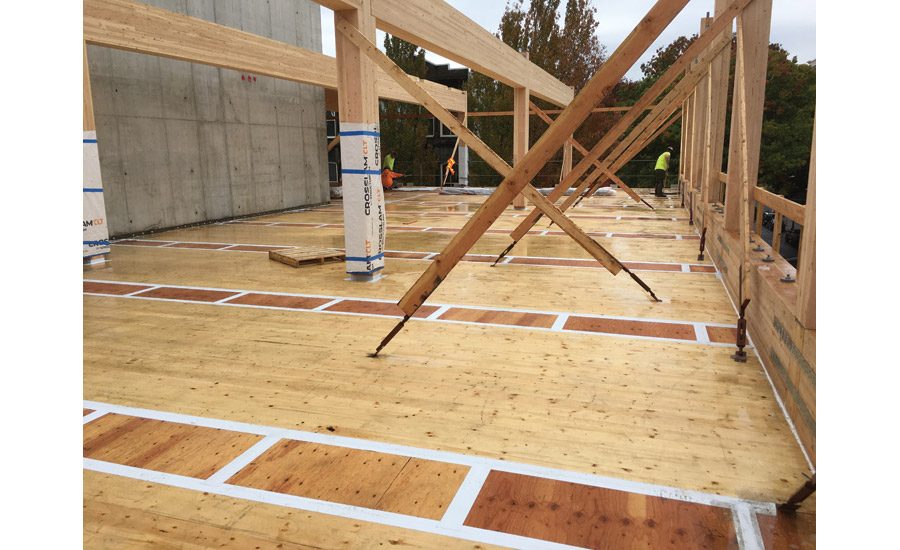
Taped seams, edges keep rain from dripping down and staining the timber below.
Photo courtesy of WCC
*Click the image for greater detail
Successful Timber Installation
Sloop attributes the successful timber installation to detailed work up front on the shop drawings. The fabricator Structurlam Mass Timber Corp., Carpentry Plus and WCC “came together to make sure every detail, connection and dimension was thought through and reviewed,” Sloop says.
One hiccup cleared early on relates to the CLT layout, which called for 9-ft-wide x 30-ft-long ceiling panels, separated by a horizontal mechanical chase—topped with concrete to create the floor diaphragm. Almost all CLT fabricators, including Structurlam, produce either 8-ft-wide or 10-ft-wide panels. Cutting wider panels 1 ft along their 30-ft length would have resulted in too much wasted material, says Alese Ashuckian, Structurlam’s mass timber specialist.
To solve the problem, Structurlam retooled its press by inserting a temporary jig to produce the 9-ft panels. Structurlam doesn’t retool its press often, says Ashuckian.
Sloop credits the expertise of Carpentry Plus as key to the success of the timber installation. For example, for stability reasons, the frame could not go higher than level three without topping slabs coming up behind it to complete the floor diaphragms.
To avoid waiting for the slab, Carpentry Plus crews nailed plywood over the spaces between panels and strapped panels together to create a temporary diaphragm. Crews topped out the frame in five instead of 10 weeks.
Another critical element to a smooth fitup was the construction of a level and plumb concrete core to receive the glulam beams, says Sloop.
WCC has already begun to adopt some aspects of the Living Building Challenge on all of its jobs. “We have put together a template for how we as builders can build more sustainably,” says Sloop. This includes power conservation, recycling and composting office waste, among other initiatives.
Sloop also says that despite the demands of the Living Building Challenge, WCC “would likely welcome the opportunity” to engage in another Living Building project. “It’s hard to say if we’d take on investor risk,” he adds. “That would depend on the job’s details.”
With work more than 85% complete, the end is in sight, as is the start of the Living Building Challenge’s 12-month occupancy period to prove the building performs as designed. Barring more hardships, September should be a month of celebration for the PAE team.
That goes double for Brotnov. This Labor Day, he expects to move into his rebuilt timber home, a replica of his burnt house, with one exception: Its CLT is made from lumber salvaged from the wildfires.
Editor's Note: This article was updated on Jan. 7, 2022.





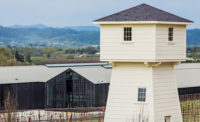
Post a comment to this article
Report Abusive Comment